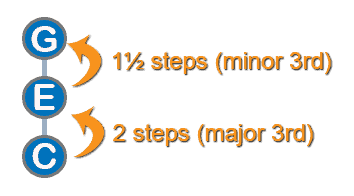
Updated September 2017
There are a lot of people who have been asking me over the years about music theory. Some were even asking me at my music school if they really need to learn theory before learning to play guitar. Theory is not critical to be a good player.
When I was in college, we talked about music theory a lot… probably more than we played music. Now, years later and after playing a lot of guitar, I realize that the “talking” we did helped me to become the player I am today.
When Does Guitar Theory Suck?
Guitar music theory has gotten a bad rap over the years. This is because it has often been taught in a way that it’s not applicable to actually playing the guitar. There is a real place for music theory for guitar, and it can especially be very helpful for beginners. The key is to avoid turning it into an intellectual pursuit that it disconnected from playing and creating beautiful music.
Should You Learn Guitar Theory?
Subjects like guitar chord theory and guitar scale theory should be learned little by little as part of a balanced program for learning to play guitar. This includes learning the terminology that will allow you to talk to other music players. By understanding some of the mechanics of how music works and the language involved you will gain a sense of confidence that the uninitiated long for.
To make the most of your effort follow these guidelines:
- Learn in small bites. Absorb and apply what you learn. This will help you connect it to the guitar and playing music.
2. Study in the correct order. Start with intervals, then learn how to apply this knowledge to chords and scales.
3. Using your ears is essential. Don’t settle for intellectual understanding only. Learn to identify the sound of intervals, chords and scales.
4. Make time to let go of thinking about music theory and just play from your heart. No amount of intellectual knowledge can replace inspiration.
Intervals - What Are They?
Intervals, along with rhythm, is one of the basic building blocks of music. An interval is a term used to describe the distance between notes. We’ll use the term "step" to describe the distance. One step is the equivalent of going from the note C to D. On the guitar you can hear one step by playing any note, then go up two frets and play another note.
That’s one whole step. One half step is - you guessed it - one fret. Another term used interchangeably with step is “tone”. One “tone” equals one step, a semi tone equals a half step, and so on.
Steps are combined to form a whole library of intervals starting from the half step.
Here’s a list of the common intervals with their names:
Beyond the octave there is a range of intervals used to name extended chords such as a 9th, 11th, 13th, b9th, #9th, and so on
Intervals Make Scales
The simplest definition of a musical scale is a series of notes that is ordered by the pitch. Scales end one octave from the note they started from. Though there are many types of scales, the most common scales for guitar are the major scale, minor scale, pentatonic scale, blues scale and chromatic scales.
Another practical way to think of a scale is that it is a series of intervals. The type and sound of the scale will change depending on the pattern of intervals. For example if you start on any note and follow the pattern for a major scale you will always have a major scale with the name of the note you started on. If you start on A, you will play an A major scale. If you start on A and play the pattern for a minor scale you will have an A minor scale. (WS means Whole Step, HS means Half Step)

Chords Are Intervals Too
Chords, like scales, are created by a combination of notes and intervals. Unlike scales, chords are notes played at the same time. When written down they look like they are stacked on top of each other.
The interval between the notes determines the type and sound of the chord. If you play notes in the pattern of a major chord, in this case a major 3rd, then a minor 3rd, you will always have a major chord. The name of the chord will come from the note that is the root (or main) note of the chord. If you play notes to form a major pattern with the A note as the root you will have an A major chord. If you played a minor pattern with an A root you have an A minor chords.

I hope you’ve enjoyed this brief discussion of music theory for guitar. If you’d like me to continue with this discussion let me know in the comment section below.
Thanks,
Tomas
P.S. To learn more about how the intervals sound on the guitar watch the video listed in the Related Videos section titled "Guitar Theory Lesson 1 - Basic Intervals"
Tell Us What You Think - Please Comment Below!
We would love to hear your comments and questions. What specific things are you struggling with while learning guitar?

Thank you for the lesson. It is very informative and I shall save it for reference.
You’re welcome Ray. I’ve got more songs on the way. Let me know which is your favorite
Great lesson!
Thanks Herb. Enjoy! 🙂
Tomas, you give so much of yourself…thank you very much.
You are most welcome, Alan! 🙂
Tomas- thank you very much. Would really love more theory. Can I ask about lhe major third/ minor third intervals you list above? Is it a major third for the major chord and a minor third for the minor chord? Or is a major chord constructed using a major third from the root to the second note of the cord and then a minor third from there to the third note?
Hi Jed, thanks for your post. Your 2nd sentence is correct. I’ll be sure and add more theory lessons in the future… But for now you might want to explore a few others that I have. I just released one a few weeks ago talking about the exact question you’re asking. https://tomasmichaud.com/guitar-chord-theory-2/ Take care Jed, Tomas
Hi there Tomas–I have been trying to play guitar for some time looked at many videos but just no luck, I am left handed and just to late to switch. I started recently watching your videos and impressed with all you know I hoping you can shed some light on helping me sound what I am playing or trying to play I would forever thank you Dale